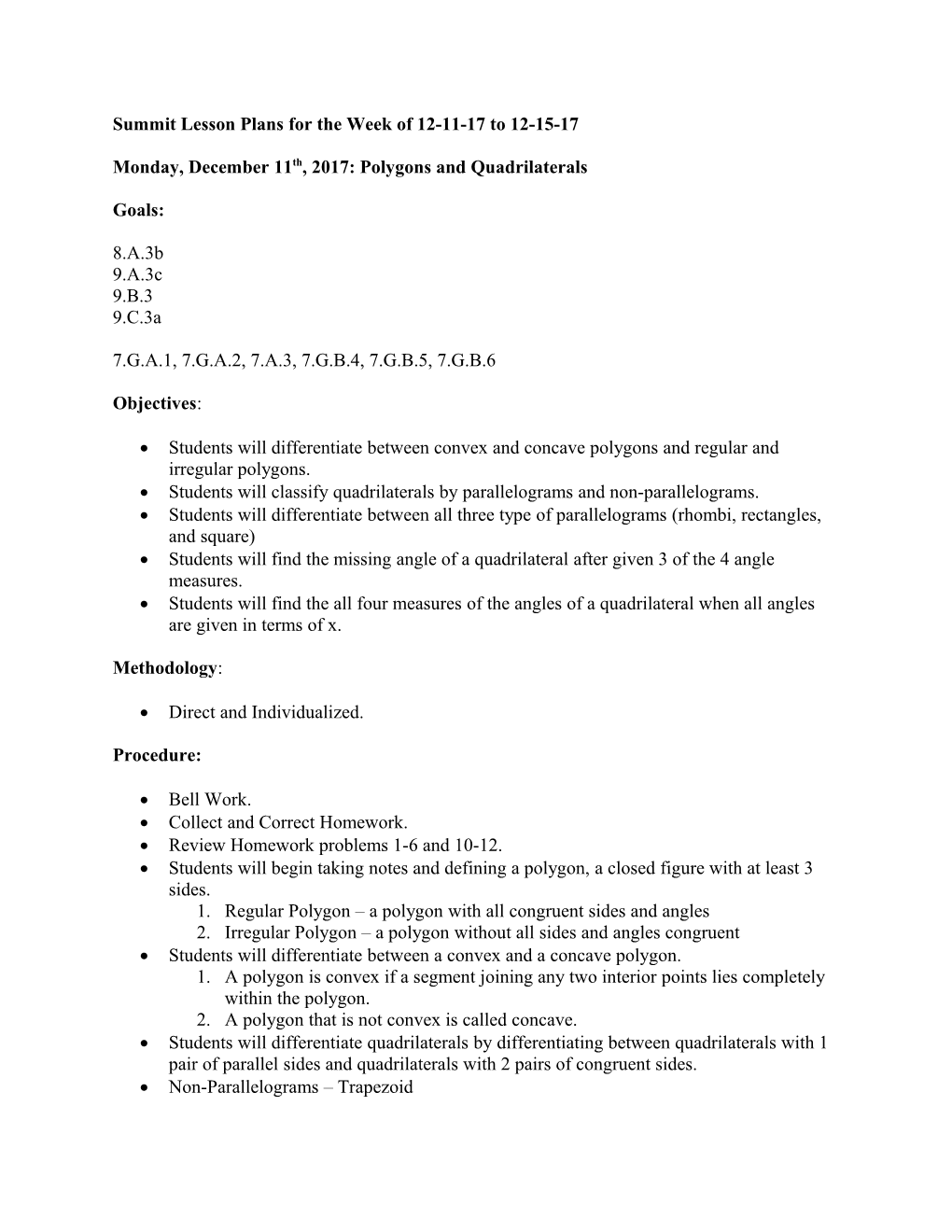Summit Lesson Plans for the Week of 12-11-17 to 12-15-17
Monday, December 11th, 2017: Polygons and Quadrilaterals
Goals:
8.A.3b
9.A.3c
9.B.3
9.C.3a
7.G.A.1, 7.G.A.2, 7.A.3, 7.G.B.4, 7.G.B.5, 7.G.B.6
Objectives:
- Students will differentiate between convex and concave polygons and regular and irregular polygons.
- Students will classify quadrilaterals by parallelograms and non-parallelograms.
- Students will differentiate between all three type of parallelograms (rhombi, rectangles, and square)
- Students will find the missing angle of a quadrilateral after given 3 of the 4 angle measures.
- Students will find the all four measures of the angles of a quadrilateral when all angles are given in terms of x.
Methodology:
- Direct and Individualized.
Procedure:
- Bell Work.
- Collect and Correct Homework.
- Review Homework problems 1-6 and 10-12.
- Students will begin taking notes and defining a polygon, a closed figure with at least 3 sides.
- Regular Polygon – a polygon with all congruent sides and angles
- Irregular Polygon – a polygon without all sides and angles congruent
- Students will differentiate between a convex and a concave polygon.
- A polygon is convex if a segment joining any two interior points lies completely within the polygon.
- A polygon that is not convex is called concave.
- Students will differentiate quadrilaterals by differentiating between quadrilaterals with 1 pair of parallel sides and quadrilaterals with 2 pairs of congruent sides.
- Non-Parallelograms – Trapezoid
- Parallelograms – Rhombus (4 congruent sides), Rectangle (4 right angles, and a square (4 right angles and 4 congruent sides).
- Students will find the missing angle of a quadrilateral after given 3 of the 4 angle measures.
- Students will find the all four measures of the angles of a quadrilateral when all angles are given in terms of x.
- Classwork: Practice 5-3
- Students will begin their homework, Are and Perimeter Packet Page One
Assessment:
- Informal individualized and whole group assessment.
- Homework:
Tuesday, December 12th, 2017: STAR Testing
Wednesday, December 13th, 2017: Area and Perimeter
- Students will use today’s class to work on their Area and Perimeter Packet.
- I will introduce Properties of Circle if time allows.
- Homework: Finish Area and Perimeter Packet.
Thursday, December 14th, 2017: Circumference and Area of Circumference
Goals:
7.G.A.1, 7.G.A.2, 7.A.3, 7.G.B.4, 7.G.B.5, 7.G.B.6
Objectives:
- Students will engage in hands-on activities to find the derivative of the formulas for circumference and area.
- Students will accurately find both the circumference and area of circles.
- Students will find the radius and/or diameter of a circle given its area or circumference.
Methodology:
- Direct and Whole Group Instruction.
Procedure:
- Bell Work Quiz.
- Correct/Collect Homework.
- Circle Notes.
- Hands-On Investigations with Coffee filter
- Guided Practice.
- Homework: 10.4/Practice B
Assessment:
- Informal individualized and whole group assessment.
- Homework: 10.4/Practice B
Friday, December 15th, 2017: Irregular Figures and Intro to Mall Project (if time allows)
Goals:
7.G.A.1, 7.G.A.2, 7.A.3, 7.G.B.4, 7.G.B.5, 7.G.B.6
Objectives:
- Students will decipher how to break irregular figures into known shapes to find the composite area.
- Students will solve real-world problems using their comprehension of composite shapes.
Methodology:
- Direct and Whole Group Instruction.
Procedure:
- Bell Work.
- Collect and Correct Homework.
- Guided Practice: Pg. 277—280: 1-4
- Guided Practice: Pg. 280: 1-4
- Number Talk/Math Challenge Problem
- Homework: Worksheet: Finding the Area of Irregular Figures.
Assessment:
- Informal individualized and whole group assessment.
- Homework: Worksheet: Finding the Area of Irregular Figures.
